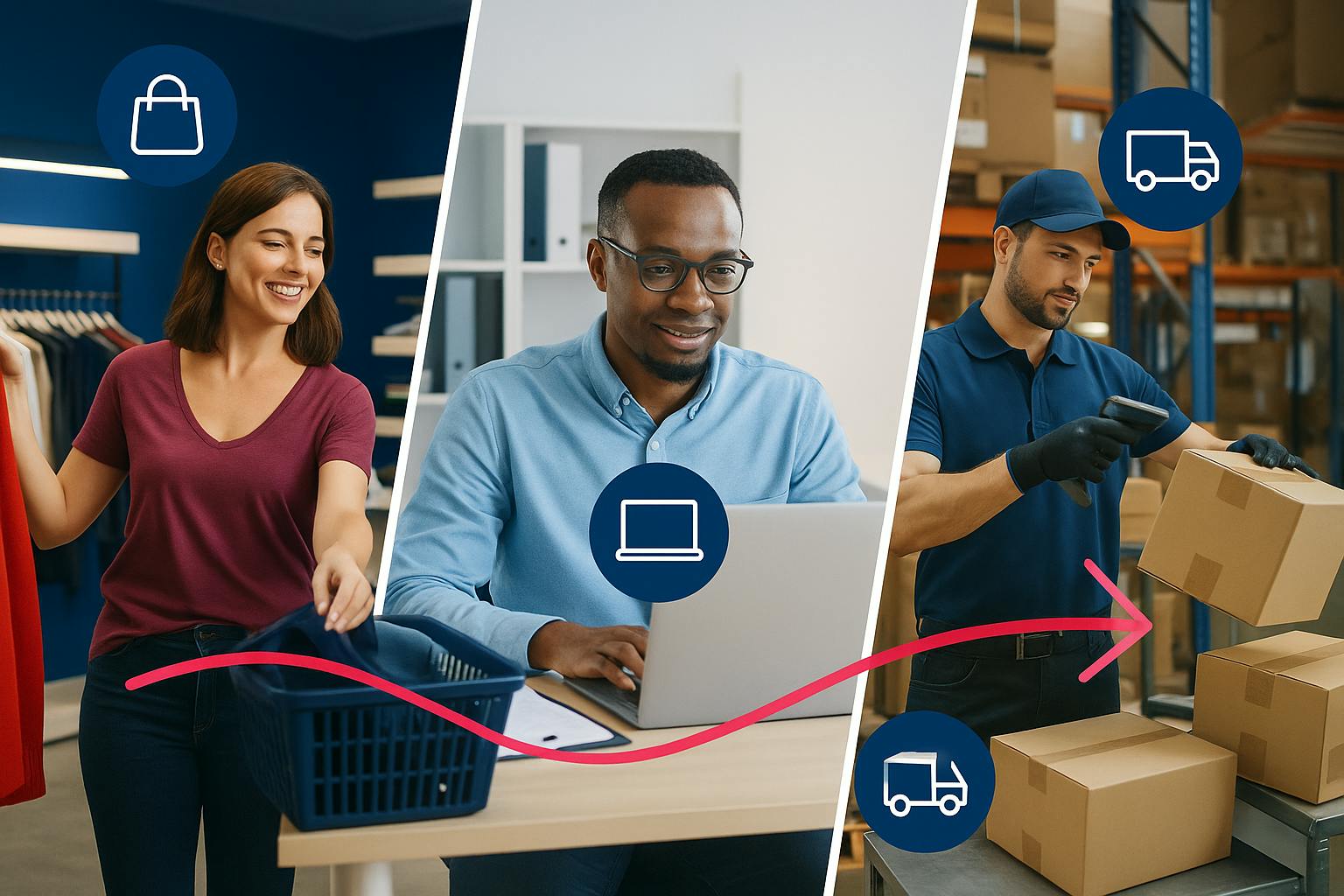
Last Mile Experience
Sep 25, 2025 - 4min read
ARTICLE
The Omnichannel Equation: Blending Online, Offline, and Fulfillment Seamlessly
Modern shoppers don't think in "channels" — they just want convenience, speed, and consistency. Whether they're browsing on mobile during their morning commute, checking inventory at lunch, or picking up their order after work, customers expect every touchpoint to work together seamlessly. Yet many retailers still treat online, offline, and fulfillment as separate silos, creating friction at every step of the customer journey.
The future of e-commerce growth lies in mastering the omnichannel equation — blending digital, physical, and fulfillment into one seamless experience that meets customers wherever they are, whenever they shop.
The Rise of Omnichannel Expectations
Today's customers have fundamentally different expectations than they did just five years ago. Recent data reveals that 81% of shoppers kick off their retail journey online before committing to a purchase, while 73% of retail consumers prefer to explore multiple channels while shopping. This isn't just a trend — it's the new reality of how consumers shop.
The numbers tell a compelling story: fifteen years ago, the typical consumer relied on just a couple of digital touchpoints for product purchases, with only 7% utilizing more than four. Nowadays, customers engage with an average of nearly six touchpoints, and 50% regularly employ more than four. Over 50% of shoppers engage with four touchpoints before making a purchase, and the average shopper utilizes nearly six.
These expectations reach a fever pitch during peak shopping seasons. Black Friday and holiday periods amplify the demand for seamless omnichannel experiences, with customers expecting to research online, compare in-store, and complete purchases through their preferred method — all without missing a beat.
The transformation is particularly evident in fulfillment preferences. 59% of U.S. consumers prefer Buy Online, Pick Up In-Store (BOPIS), and BOPIS is growing rapidly. 97.2 million Americans regularly use BOPIS in 2024, representing 34.2% of U.S. consumers, and sales are projected to reach $154.3 billion in 2025. Even more compelling: a majority of BOPIS users make additional in-store purchases during pickup. This hybrid approach to shopping isn't an exception — it's becoming the rule.
Common Omnichannel Gaps
Despite growing consumer expectations, most retailers struggle with significant gaps that prevent true omnichannel success. 71% of consumers expect seamless interactions across all channels, yet only 29% of businesses deliver that. This disconnect creates real pain points that damage customer relationships and business performance.
Inventory visibility remains one of the biggest challenges. 71% of consumers expect brands to offer visibility across both online and in-store inventory, yet many retailers still operate with disconnected systems that can't communicate in real-time. A customer sees an item in stock online, drives to the store, only to find it's sold out — creating frustration that often drives them to competitors.
Disconnected carrier networks compound these problems. Without unified tracking and communication systems, customers receive inconsistent information about their orders depending on which channel they use. An online order might have detailed tracking, while a ship-from-store order provides minimal visibility, creating confusion and anxiety.
Returns management presents another significant gap. Customers expect to return online purchases in-store or vice versa, but many retailers still handle returns through siloed processes. This creates friction exactly when customers are most vulnerable to switching brands — when something has gone wrong with their purchase.
Pricing and promotional misalignment between channels creates additional friction. Customers notice when online prices differ from in-store prices, or when promotions aren't honored across channels. These inconsistencies erode trust and make customers question whether they're getting the best deal.
The Omnichannel Equation: What Success Looks Like
True omnichannel success requires solving for four critical variables in the equation:
Unified Inventory means customers see accurate, real-time stock information whether they're shopping online or in-store. No more disappointment, no more wasted trips. When inventory systems are properly integrated, customers can confidently check availability, reserve items, and choose their preferred fulfillment method.
Flexible Fulfillment encompasses the full spectrum of modern shopping preferences. BOPIS sales are projected to reach $154.3 billion in 2025, representing remarkable growth driven by customer demand for flexibility. 97.2 million Americans regularly use BOPIS in 2024, representing 34.2% of U.S. consumers. But true flexibility goes beyond BOPIS to include ship-from-store, same-day delivery, curbside pickup, and any combination that meets customer needs.
Consistent Post-Purchase Experience ensures that tracking, communications, and support remain seamless regardless of how or where the customer placed their order. A unified system provides consistent updates, branding, and service quality across all touchpoints.
Customer-Centric Experience means one brand, one journey — no matter how the customer chooses to shop. Every interaction should feel connected and personalized, building on previous touchpoints rather than starting from scratch.
Carriyo's Role in Solving the Equation
Solving the omnichannel equation requires the right technology foundation, and this is where Carriyo transforms operations for leading retailers.
Multi-Carrier Integration enables the flexible last-mile delivery that modern customers demand. Whether an order needs to go from warehouse to customer, store to customer, or any variation in between, Carriyo's network of 100+ carrier integrations ensures retailers can choose the best option for speed, cost, and customer preference. This flexibility is crucial as 80% of retailers plan to implement BOPIS services by 2025.
Branded Tracking Pages solve the consistency challenge by providing a unified experience regardless of fulfillment method. Whether a customer's order ships from the main warehouse, a local store, or a third-party fulfillment center, they receive the same professional, branded experience with consistent information and upselling opportunities.
Proactive Notifications keep customers informed across their preferred channels — email, SMS, or WhatsApp. These automated updates reduce "where is my order" inquiries while maintaining engagement throughout the post-purchase journey. 71% of consumers expect consistent experiences across channels, and proactive communication helps meet these expectations.
Comprehensive Returns Portal simplifies cross-channel returns by providing customers with a self-service option that handles any return scenario. Whether they bought online and want to return in-store, or purchased in-store and prefer to return by mail, the system seamlessly handles the logistics while maintaining a consistent brand experience.
Centralized Dashboard gives retailers a single view of their entire fulfillment operation. From this unified command center, operations teams can monitor performance across all channels, identify bottlenecks before they impact customers, and make data-driven decisions to optimize the entire network.
Case Study: Achieving Omnichannel Excellence
Consider the transformation experienced by retailers featured in Carriyo's case studies. Sephora, faced with managing customer expectations at scale across millions of loyal customers, implemented Carriyo to create an integrated inventory management and fulfillment execution workflow across fulfillment centers. The results speak for themselves: a 30% reduction in customer service calls within the first month, unified shipment tracking for all customers, and a 200% increase in shipping volume.
Similarly, Level Shoes achieved remarkable results by implementing Carriyo as part of their digital transformation program. The luxury retailer now manages hyperlocal, regional, and international fulfillment operations from a single streamlined operation, monitoring activities continuously to identify at-risk deliveries. The impact was immediate: 96% service level across all service types, zero manual effort to manage and print shipping documents, and real-time visibility of shipment status.
These success stories demonstrate what's possible when retailers properly solve the omnichannel equation. Shoppers are significantly more likely to return to businesses offering connected omnichannel experiences, and these retailers have built the foundation for that loyalty.
Preparing for 2025
As we move into 2025, the omnichannel equation becomes even more critical. The click-and-collect (BOPIS) channel alone is projected to represent over 10% of all U.S. e-commerce sales by 2025, totaling $154.3 billion, demonstrating the rapid adoption and implementation of omnichannel strategies across various retail sectors. Retailers who haven't solved this equation risk being left behind.
The first step is breaking down organizational silos between e-commerce, retail stores, and logistics teams. These departments must work toward shared goals and KPIs rather than optimizing their individual channels. For a transformation to succeed, all parts of the organization must row in the same direction.
Next, retailers need to audit their fulfillment workflows with a critical eye. Are inventory systems truly connected? Can a customer return an online purchase to any store location? Do tracking and communication systems provide consistent experiences regardless of fulfillment method? Any gaps in these areas represent opportunities for competitors to win customers.
Finally, investing in the right technology infrastructure is crucial. Omnichannel technology should seem invisible to customers when they're shopping. The complexity should be hidden behind seamless experiences that delight rather than frustrate.
Conclusion
Omnichannel is no longer optional — it's the new baseline for retail success. Retailers with strong omnichannel strategies outperform those with weak ones in both revenue growth and customer retention. The math is simple: retailers who solve the omnichannel equation thrive, while those who don't struggle to keep up with customer expectations.
Customers don't care how complex fulfillment operations are behind the scenes; they just care about a smooth, consistent journey from discovery to delivery and beyond. They want to start shopping on their phone, check inventory at a nearby store, complete their purchase online, and pick up their order at their convenience — all while receiving consistent communication and service quality.
With Carriyo, retailers can solve the omnichannel equation by seamlessly blending online, offline, and fulfillment into one powerful customer experience. The platform handles the complexity of multi-carrier integration, inventory synchronization, and cross-channel communication, allowing retailers to focus on what matters most: delighting customers and growing their business.
The question isn't whether to embrace omnichannel — it's whether to lead the transformation or follow it. If you're ready to solve the omnichannel equation and create the seamless experiences your customers demand, contact our sales team or book a demo today. Your customers — and your bottom line — will thank you.
01

Joao Vieira
CRO at CARRIYO
Inside the City: How Urban Freight and Micro-Distribution Are Redefining the Last Mile
Oct 7, 2025 - 4min read
02

Faisel Azeez
Co-Founder & CTO
Connected Fleets: How Telematics and Data Are Powering the Next Generation of Logistics
Oct 6, 2025 - 5min read
03

Joao Vieira
CRO at CARRIYO
Last Mile, First Priority: Why Experience Matters More Than Speed
Oct 2, 2025 - 5min read
Automate shipping operations and elevate post-purchase customer experience
We're trusted by

